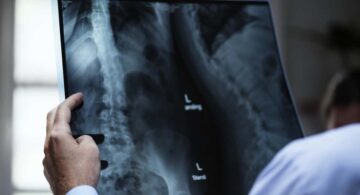Technology is developing at a rapid pace, changing the way that we live our lives and making everyday tasks more streamlined and efficient. This is true in the realms of healthcare, where the latest equipment is transforming the way that care is delivered and enhancing the patient experience.
Wearable technology is one sub-set of this area that is enabling better patient outcomes. In this article, we’ll take a look at health-related wearable technology and explore how nurses can interact with it for great results. We’ll also touch on the changing role of nurses and the opportunities to take this career to new heights thanks to targeted further education and training.
Unlock Nurses Embracing Wearable Technology for Improved Patient Outcomes
What Is Wearable Technology?
Wearable technology refers to electronic devices that track and analyze data. One of the most well-known examples of wearable technology is a smartwatch or fitness tracker that can track or detect a whole range of biometric data, including:
- Heart rate
- Irregular heart rhythm
- Breathing rate
- Skin temperature
- Blood oxygen saturation
- Blood glucose tracking
- Sleep
Functions also include fitness data – for example, steps or distance taken and cardio fitness – making these devices useful tools for not only tracking the wearer’s health but also motivating them to make healthy lifestyle choices.
Wearable technology is not limited to smartwatches – other products include devices worn around the neck to monitor heart function and contact lenses to track eye pressure, for example. However, the smartwatch is the most accessible and familiar device that collects and analyzes health data and is what we will focus on here.
Nurses And Wearable Technology
Technology is changing the way that nurses and patients interact. This is especially relevant when it comes to the role of nurse practitioners, one that is increasingly popular in the US.
These highly trained nursing professionals operate with more autonomy, performing tasks that would traditionally only be performed by physicians, such as diagnosing health conditions and writing treatment plans, and they are embracing the benefits that smart devices offer.
At a consultation with a nurse practitioner, a patient enabled with a smartwatch will typically be able to deliver real-time (and older) health information to their nurse. This means that the nurse practitioner can identify health issues quickly and intervene in a timely manner.
The way that this data is delivered – directly from the patient – also adds a fresh dimension to the patient-nurse relationship, breaking down old barriers and transforming consultations into exchanges between two equal partners.
The availability of personal health data to the patient also enhances one of the many facets of the nurse practitioner’s role – that of promoting health and well-being and preventing disease.
Patients who use wearable devices are motivated to take ownership of their health without the nurse practitioner having to cajole or persuade them into following a healthy lifestyle – having instantly available data encourages the patient to set health goals. This in turn means that the patient and nurse practitioner are working together as a team to achieve these goals.
The availability of personal health data also makes the process of seeing patients easier and more streamlined. Nurse practitioners can consult with patients via telemedicine services, through phone calls or videoconferences, using the data that the patient has provided.
This is invaluable for patients living in remote or rural areas or for those who are elderly, house-bound, or in areas where there is inadequate provision of healthcare services.
Because the data is collected automatically, nurse practitioners don’t have to worry about its accuracy. It’s precise, and personalized, and gives the nurse an overarching view of their patient so that they can accurately assess the entirety of their healthcare needs.
Wearables have already changed the way that patients and nurses interact, strengthening their relationships and improving outcomes for patients.
The Changing Role Of Nurses
If you are a nurse and are intrigued by the way that your role is being transformed by technology, there are numerous further education opportunities to take your career to the next level.
As we’ve seen, nurse practitioners are increasingly working with technology, including wearables, to enhance patient care and improve outcomes.
The nurse practitioner role lends itself to this new way of working as it’s focused not only on dealing with immediate health issues but also on supporting patients to manage their own health and well-being.

If this role appeals to you, why not explore an online program to qualify as a family nurse practitioner (FNP) or adult-gerontology acute care nurse practitioner (AGACNP)? As an FNP, you’ll be supporting patients in primary care across their lifespan, while as an AGACNP, your role will involve offering acute and critical care to adult patients, including the elderly.
Both roles benefit from the latest technological breakthroughs, helping nurses to work in collaboration with patients and their families and deliver the best outcomes.
If you are weighing up FNP vs AGACNP career paths, you can read about the differences between them on Rockhurst University’s blog, linked here. As well as offering separate courses for each specialty, Rockhurst University has a combined dual-track program that allows you to gain certifications both as an FNP and an AGACNP. This program opens up your scope of practice and prepares you to work in this exciting field via self-paced online study and clinical placements. It’s the ideal pathway for dynamic nursing professionals who wish to extend their skills and experience and deliver a vital service to patients of all ages.
Qualifying as a nurse practitioner will also lay the foundations for a long and fruitful career. You’ll experience the satisfaction of helping patients at every stage of their healthcare journey and also be assured by the long-term prospects this role offers you. According to the US Bureau of Labor Statistics, the mean annual wage for nurse practitioners sits at a healthy $124,680.
Be Part Of The Future Of Healthcare
The healthcare landscape is a dynamic, interactive playing field where healthcare professionals such as nurse practitioners and their patients collaborate for the best outcomes.
If you want to be part of the future of healthcare, consider extending your skills and enrolling in a program to qualify as an FNP, an AGACNP, or even both! Gaining these valuable certifications will prepare you for an exciting career where you can harness the latest tech to deliver the very best care to your patients.
- SEO Powered Content & PR Distribution. Get Amplified Today.
- PlatoData.Network Vertical Generative Ai. Empower Yourself. Access Here.
- PlatoAiStream. Web3 Intelligence. Knowledge Amplified. Access Here.
- PlatoESG. Carbon, CleanTech, Energy, Environment, Solar, Waste Management. Access Here.
- PlatoHealth. Biotech and Clinical Trials Intelligence. Access Here.
- Source: https://iotworm.com/how-nurses-interact-with-wearable-technology-for-better-patient-outcomes/
- :has
- :is
- :not
- :where
- $UP
- 1
- 400
- a
- Able
- About
- According
- accuracy
- accurately
- Achieve
- across
- acute
- Adds
- Adult
- Ages
- All
- all ages
- allows
- already
- also
- an
- analyze
- analyzes
- and
- annual
- appeals
- ARE
- AREA
- areas
- around
- article
- AS
- assess
- assured
- At
- automatically
- Autonomy
- availability
- available
- barriers
- BE
- being
- benefit
- benefits
- BEST
- Better
- between
- biometric
- Blog
- both
- Breaking
- breakthroughs
- Bureau
- but
- by
- Calls
- CAN
- care
- Career
- certifications
- changed
- changing
- choices
- Clinical
- collaborate
- collaboration
- collects
- combined
- comes
- conditions
- Consider
- consultation
- consultations
- contact
- courses
- critical
- data
- dealing
- deliver
- delivered
- detect
- developing
- device
- Devices
- diagnosing
- differences
- Dimension
- directly
- Disease
- distance
- Dont
- down
- dynamic
- each
- easier
- Education
- efficient
- Elderly
- Electronic
- embracing
- enabled
- enabling
- encourages
- enhance
- Enhances
- enhancing
- entirety
- equal
- equipment
- especially
- Even
- Every
- everyday
- example
- examples
- Exchanges
- exciting
- experience
- explore
- extend
- extending
- eye
- facets
- familiar
- families
- family
- field
- fitness
- Focus
- focused
- following
- For
- Foundations
- fresh
- from
- fruitful
- function
- further
- future
- Gain
- gaining
- gives
- Goals
- great
- harness
- Have
- having
- Health
- health information
- healthcare
- healthy
- Heart
- heights
- helping
- here
- highly
- How
- However
- HTTPS
- ideal
- identify
- immediate
- improve
- improved
- improving
- in
- include
- Including
- increasingly
- information
- instantly
- interact
- interactive
- intervene
- into
- invaluable
- involve
- iot
- issues
- IT
- ITS
- itself
- journey
- labor
- landscape
- latest
- lay
- lenses
- Level
- lifespan
- lifestyle
- Limited
- linked
- live
- Lives
- living
- Long
- long-term
- Look
- make
- MAKES
- Making
- manage
- manner
- many
- max-width
- mean
- means
- Monitor
- more
- most
- motivated
- motivating
- needs
- New
- next
- numerous
- Nursing
- of
- offer
- offering
- Offers
- Old
- older
- on
- ONE
- online
- only
- opens
- operate
- opportunities
- or
- Other
- our
- outcomes
- overarching
- own
- ownership
- Oxygen
- Pace
- part
- partners
- pathway
- patient
- patient care
- patients
- performed
- performing
- personal
- Personal Health
- Personalized
- phone
- phone calls
- placements
- plans
- plato
- Plato Data Intelligence
- PlatoData
- playing
- Popular
- practice
- precise
- Prepare
- Prepares
- pressure
- preventing
- primary
- process
- Products
- professionals
- Program
- promoting
- prospects
- provided
- provision
- qualify
- quickly
- range
- rapid
- Read
- real-time
- realms
- refers
- relationship
- Relationships
- relevant
- remote
- Results
- Role
- roles
- Rural
- Rural Areas
- satisfaction
- scope
- seeing
- seen
- separate
- service
- Services
- set
- sits
- skills
- smart
- smartwatch
- smartwatches
- So
- Specialty
- Stage
- Steps
- streamlined
- strengthening
- Study
- such
- Supporting
- Take
- taken
- targeted
- tasks
- team
- tech
- technological
- Technology
- telemedicine
- thanks
- that
- The
- The Future
- their
- Them
- There.
- These
- they
- this
- those
- Through
- timely
- to
- together
- tools
- touch
- track
- Tracking
- traditionally
- trained
- Training
- transformed
- transforming
- treatment
- true
- TURN
- two
- typically
- university
- us
- use
- useful
- using
- Valuable
- very
- via
- View
- vital
- vs
- wage
- want
- Way..
- we
- wearable
- wearable devices
- wearable technology
- wearables
- webp
- weighing
- WELL
- well-known
- What
- when
- while
- WHO
- whole
- why
- will
- wish
- with
- without
- Work
- working
- worm
- worry
- would
- writing
- you
- Your
- zephyrnet












